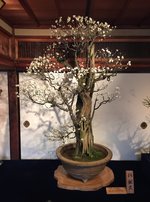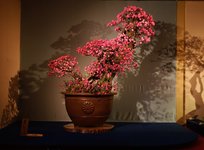Bjorn recently posted a short version of the history of bonsai, and Prunus mume are mentioned a few times:
https://bjornbjorholm.com/bonsai-history-japan/
One could argue that the reasons for their usage are cultural, historical, agricultural, artistic, as well based on regional availability and so on, and there is truth to all of that. But none of that can explain why
I as a Canadian, and so many others outside of China and Japan, are captivated by Ume. For me, it is the contrast of the bark and deadwood with the delicate flowers, combined with the health and training challenges, that make Ume not only the best species of Prunus, but a supreme material for bonsai:
If you're going to have fun with bonsai, ume are the best... for me anyway - Nobuyuki Yanai
Putting the question of bonsai aside for a moment, I think it's worth noting that Ume scores incredibly high in 4 out of 5 human senses: touch, sight, smell and taste, giving it a cumulative score that surpasses most other species. (You can add hearing if you count the birds and squirrels that come ravage the fruit).
My personal interests are with Ume in pots that are much larger than what we generally consider bonsai (see attached). The extremely wide variety of Ume flowers plays a larger role in this domain than it does in bonsai proper.








